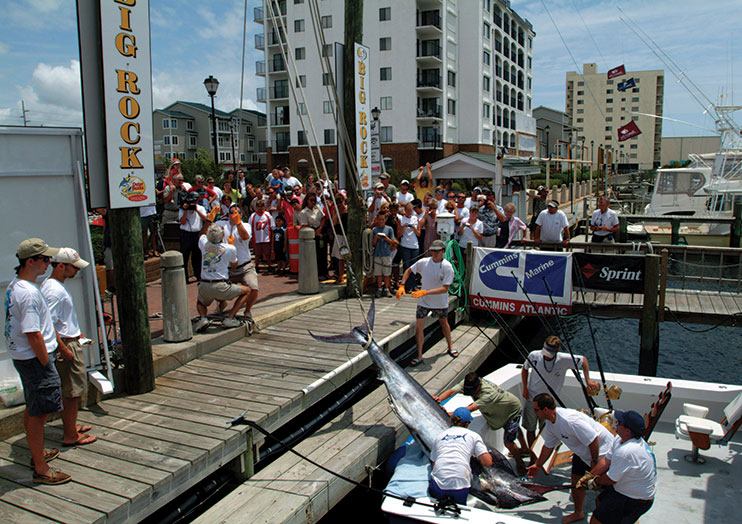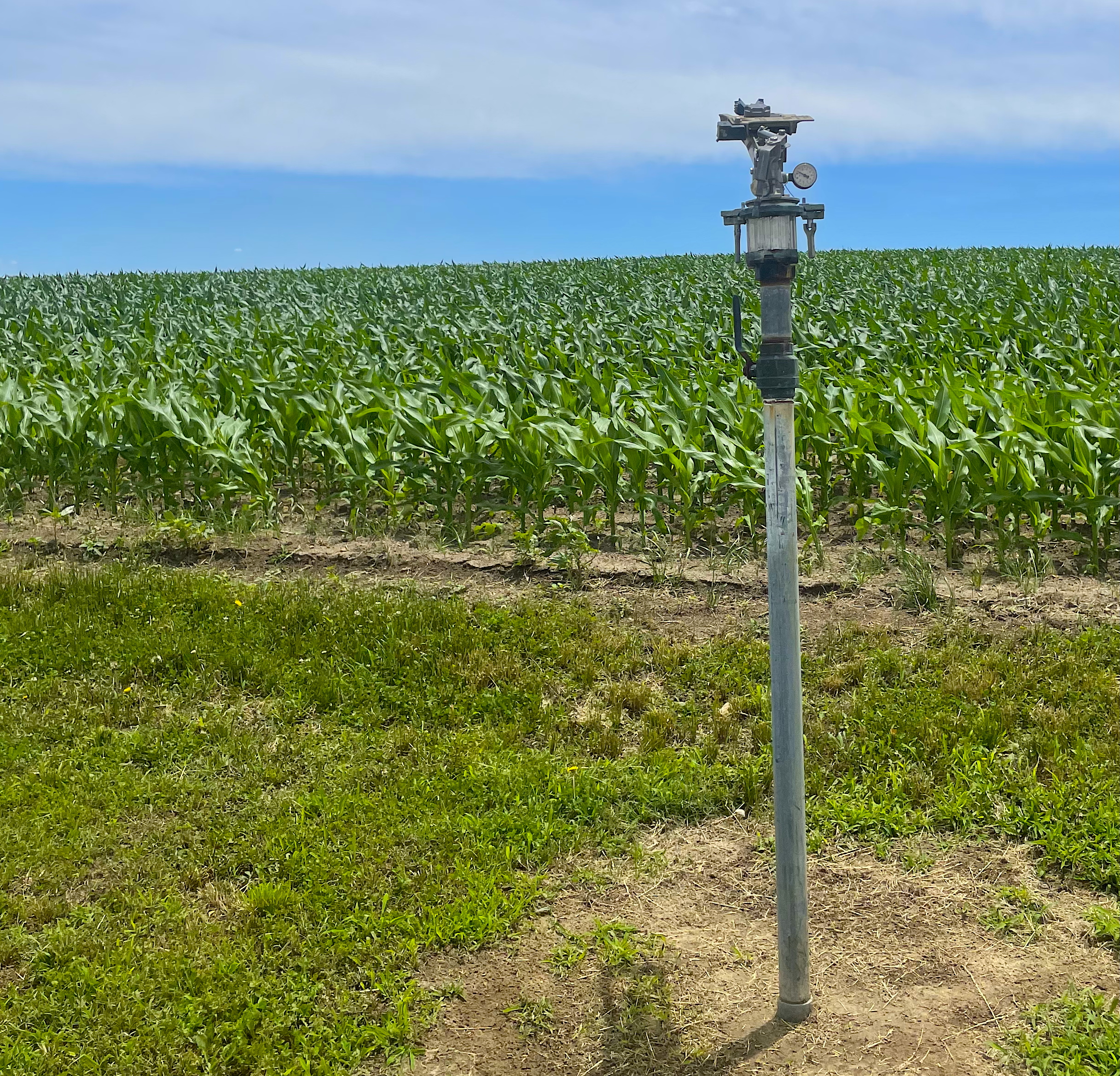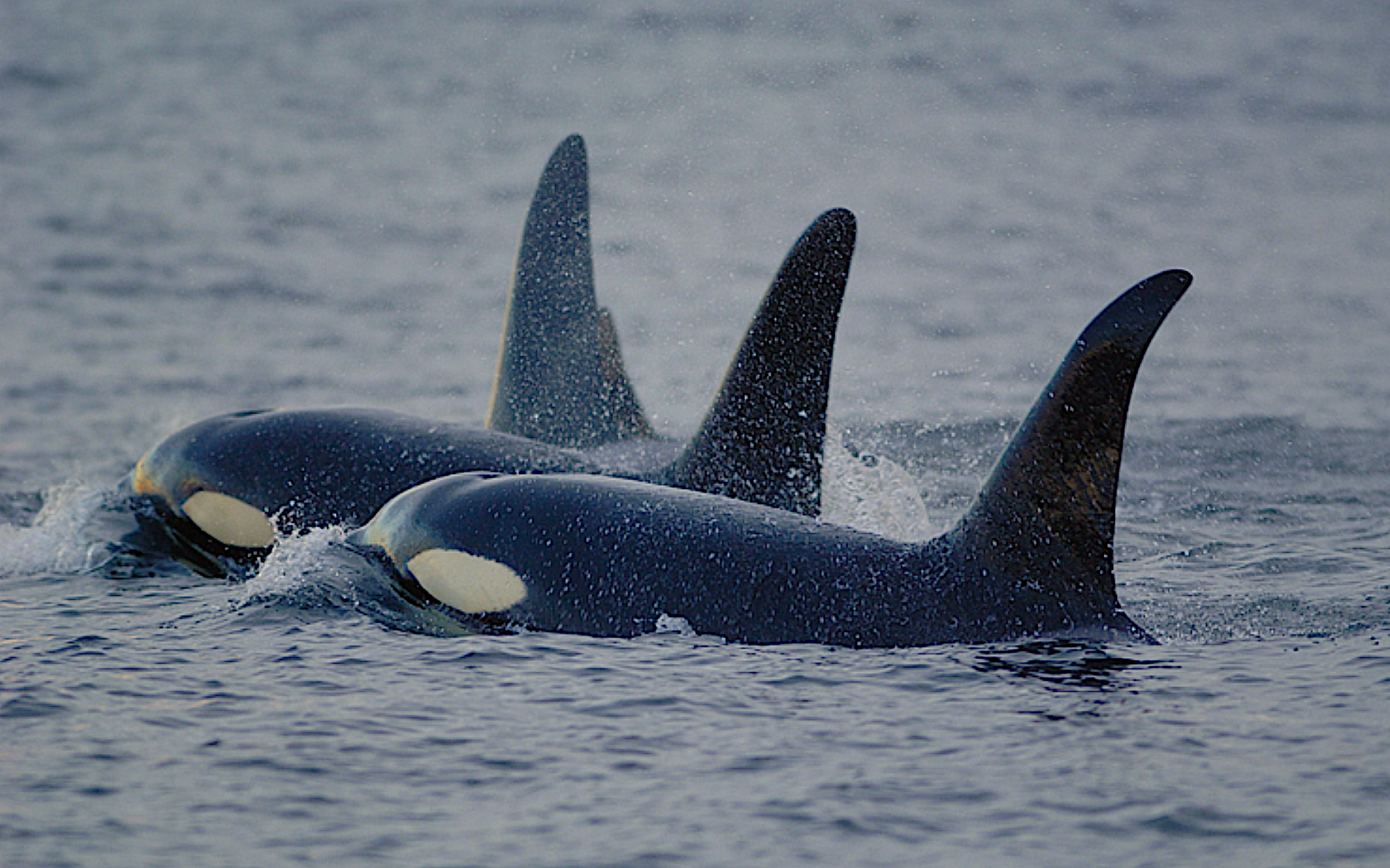Fishing the Deep-Blue Sea: New Federal Permit Required for Highly Migratory Species

“When fishing for marlin, you can sit around four or five hours and nothing happens,” says John Graves, a recreational angler and chairman of the Virginia Institute of Marine Science’s Department of Fish Science.
“Then in an instant, there can be complete pandemonium when fish tear into the bait,” adds Graves. “Sometimes, it can take a couple of hours or more to pull a marlin in.”
And as a member of a federal billfish advisory panel, Graves is helping to spread the word to private anglers that they are required by law to get a federal permit if they fish recreationally for highly migratory species, which include sharks, tunas, swordfish and billfishes.
Known as HMS, these fish are among the largest, fastest and pound-for-pound the most economically valuable creatures in the ocean. The permit is required whether anglers engage in catch-and-release fishing or land the fish.
Graves says HMS permits provide a good conservation measure for fish stocks that need to be rebuilt. “Requiring private boats to have permits and report their landings gives NOAA Fisheries a better way of estimating recreational catches of big game fish species.”
As their name implies, HMS swim throughout the world’s oceans, and the stocks are shared by a number of fishing nations. They may spend different life stages or seasons in various habitats, moving up and down the coast, or from inshore to deep ocean waters.
Although these fish primarily live in the open ocean, the category also includes certain sharks that frequent closer waters for mating, pupping and nursery purposes.
Today, blue and white marlin are among the HMS prized by recreational anglers in the Atlantic, Gulf of Mexico and U.S. Caribbean.
“It is real exciting watching a marlin come up in bait spread behind the boat,” says Pete Manuel, owner of the Delta Dawn charter boat in North Carolina. “When marlin get excited, they light up like a neon sign.”
New HMS Permits/Landings
The National Marine Fisheries Service, part of the National Oceanic and Atmospheric Administration (NOAA) and better known as NOAA Fisheries, works with other nations through the International Commission for the Conservation of Atlantic Tuna (ICCAT).
“Federal officials work to ensure that Americans get a fair share of international quotas,” says Chris Rogers, chief of NOAA Fisheries’ Atlantic Highly Migratory Species Management. “As a leading advocate for international environmental stewardship of big game fish, our country has a vested interest in making sure Americans do not overharvest the U.S. quota each year.”
To ensure that quota is met but not exceeded, in 2003 NOAA Fisheries began requiring private anglers to get vessel permits to fish for regulated HMS in the Atlantic, Gulf and U.S. Caribbean waters. Previously, the permits were required only when fishing for tunas.
“With the growing popularity of sportfishing, this step was necessary to determine how many American citizens participate in HMS fisheries — essential information for negotiating international quotas that ultimately determine recreational catch allowances for the United States,” adds Rogers.
The federal permit is required for private recreational boats that fish for Atlantic tunas, swordfish, sharks, blue and white marlin, sailfish and spearfish. It covers all passengers on board. A separate HMS permit covers charter and headboat customers.
“In general, sportfishermen are very serious about conservation,” says Rogers. “Compliance with the permit and reporting requirement has been disappointingly low to date, so we are stepping up our outreach efforts to educate people about the new requirements and how compliance will ultimately help the recreational fishing community.”
The new permit and reporting systems are designed to strengthen certainty in fisheries data. “The new systems will improve everyone’s faith in the data used to set catch limits and establish other conservation needs,” says Rogers.
To improve communication with the recreational fishery community, NOAA Fisheries and North Carolina Sea Grant recently held a workshop to discuss HMS fisheries permits, quotas and outreach to the recreational fishing community. Charter boat captains, billfish tournament directors and recreational anglers attended the workshop, to give NOAA Fisheries an “on the dock” perspective.
“NOAA Fisheries needs the cooperation of the recreational fishing community to rebuild highly migratory fisheries,” says North Carolina Sea Grant Extension Director Jack Thigpen. “We can help to bring all sides together for an open discussion.”
The landings data are used both for science and fisheries management, according to Bill Price, NOAA Fisheries’ HMS national liaison to billfish tournaments. “The ultimate goal is improved stewardship of highly migratory species,” says Price.
Bluefin Tuna
Many recreational anglers are enticed by the thrill of catching a giant tuna that can weigh up to 1,000 pounds.
“You either need a stand-up harness or fighting chair when fishing for bluefin,” says Capt. Donnie Lee of the Diamond Girl Sport Fishing Charter in Morehead City, N.C. “The fight for a bluefin can go on from 20 minutes up to more than four hours.”
Managing the tuna fisheries is also a great challenge — and thus many quota decisions can be controversial. For example, in 2003-2004, NOAA Fisheries limited recreational bluefin tuna fishing in North Carolina, Virginia, South Carolina and Georgia to release only, a decision that frustrated many anglers in those states.
“The Atlantic bluefin tuna fishery poses management challenges because of the unpredictable migration pattern of the stock as it travels south each year,” says Rogers. “In some years, the coastwide quota is reached before the tuna swim into South Atlantic waters.”
Factors include ocean currents and weather patterns. “Sometimes the fish are too far offshore south of Virginia, forcing citizens of those states to travel north to participate in the fishery,” he adds.
“This year, in an effort to help distribute fishing opportunities, NOAA Fisheries extended the HMS season from the end of December to the end of January.”
In the past decade, North Carolina in particular has had an interest in the commercial and recreational bluefin quotas. Since the mid-1990s, giant bluefin tuna have concentrated near shipwrecks off Cape Hatteras and Cape Lookout National Seashores during winter months.
When quotas are available, the bluefin fishery can extend the season for the charter and headboat industry, turning Hatteras and Morehead City into destinations for recreational anglers, says Louis Daniel, assistant to the director of the N.C. Division of Marine Fisheries (NCDMF).
“Fishing for bluefin tuna has become a world-class fishery because of the size of the fish caught,” adds Daniel, who also serves on a federal fisheries management council.
Swordfish Limit
North Atlantic swordfish are showing promising signs of recovery just four years into a 10-year recovery program. However, much of the new stock consists of small juvenile fish that need continued protection.
NOAA Fisheries attributes the recovery to the conservation efforts of anglers and restrictive fishing limits placed on the commercial industry.
Federal regulators recently began limiting recreational swordfish catches to one per person, up to three per boat, per day. This applies to all recreational vessels, including charter and headboats fishing in federal waters of the Atlantic and Gulf of Mexico.
The retention limit is designed to discourage illegal sales as well as to ensure the protection of juvenile fish in nursery areas. In addition, there is a minimum size limit for recreational fisheries of 47 inches (whole fish) to protect juveniles.
Capt. Kevin Kates of Intrinsic Value out of Pompano Beach, Fla., says the limits need to be enforced in order to sustain the swordfish fishery. “Before the new limits, a lot of sword-fish were being killed,” he says.
Atlantic waters off Florida are one of the few places in the world where, on any given night, anglers get a chance to catch a sword-fish, Kates adds. Depending on the night, a boat generally can catch one to three swordfish around the Pompano Beach area.
Sharks
New regulations recently took effect for Atlantic, Gulf of Mexico and Caribbean shark fisheries, increasing recreational catch limits and defining recreational shark fishing gear as rod and reel and handlines.
Recreational anglers now may possess one shark per vessel per trip, with a minimum size limit of four and a half feet. In addition to this limit, sportfishers may take one bonnethead per person per trip with no minimum size limit and one Atlantic sharpnose per person per trip, with no minimum size limit.
“These recreational regulations compliment a suite of new commercial fishing limits on sharks, including large cutbacks in annual quotas, gear restrictions, and a closure January through July each year off North Carolina to protect shark pupping grounds,” Rogers explains.
Circle Hooks
To reduce the mortality of billfish and other HMS, many groups — including Sea Grant programs, NOAA Fisheries, fishing clubs and tournament boards — encourage the use of circle hooks in recreational fisheries.
For example, since the mid-1990s, NOAA Fisheries has supported training and outreach efforts in proper baiting and hooking techniques.
Anglers also are encouraged to use circle hooks in tournaments. In 2003, the Big Rock Marlin Tournament in Morehead City began giving additional release points for use of circle hooks.
“In the long-term, using circle hooks will enhance recreational fishing opportunities by maintaining healthy stocks,” says Rogers.
“White marlin is on the ‘species of concern’ list, which serves to encourage conservation action and provide public notice that it may warrant future listing under the Endangered Species Act. We have to increase post-release survivability, or we could eventually see a halt to any fishing that has potential to catch one,” he explains.
The principle behind the circle hook is simple. After the hook is swallowed, natural pressure applied to the line by the fish pulls the hook out of the stomach.
The unique hook shape causes the hook to slide towards the point of resistance and typically lodge in the jaw or corner of the fish’s mouth. The actual curved shape of the hook keeps it from catching in the gut cavity or throat.
“We are doing a better job of educating blue-water fishermen about circle hooks,” says retired North Carolina Sea Grant fisheries specialist Jim Bahen, who has conducted numerous circle hook workshops. “Research has shown that circle hooks reduce the mortality of released fish compared to deep hooking, where fish swallow bait.”
A1999 NOAA Fisheries study found the rates of fishing success for billfish were comparable or higher for circle hooks compared to J-hooks. Circle hooks used on sailfish had hooking percentages — including fish hooked or fish bite — that were 1.83 times higher than J-hooks.
Eighty-five percent of sailfish were hooked in the comer of the mouth using circle hooks as compared to 27 percent for J-hooks. In addition, 46 percent of sailfish were deep hooked in the throat and stomach with J-hooks, compared to 2 percent with circle hooks.
Billfish Tournaments
A popular activity for HMS anglers is participation in fishing tournaments. Anglers who participate in any of the tournaments offered throughout the Atlantic, Gulf of Mexico and Caribbean also can help in conservation of HMS.
“By getting the required angling permit — which is required even of catch-and-release fishing in tournaments — and making sure landings are reported through the tournament, participants will be helping to ensure a successful future for these popular and fun fishing competitions,” says Rogers.
In the Atlantic, Gulf and Caribbean, recreational anglers annually compete in approximately 200 billfish tournaments registered with NOAA Fisheries.
For example, in North Carolina, seven billfish tournaments are included under North Carolina’s Governor’s Cup Billfish Conservation Series. Boaters and anglers accumulate points for billfish catches in participating tournaments to compete for the Governor’s Cup.
There are a number of other large billfish tournaments along the Atlantic coast, such as the Hatteras Marlin Tournament and the Pirate’s Cove Big Game Tournaments off the Outer Banks; the White Marlin Open in Ocean City, Md.; the Virginia Beach Red, White and Blue; the Florida Billfish Masters in Miami Beach; the Annual Silver Derby Sailfish in West Palm Beach; the NE Florida Marlin Association Blue Water in St. Augustine; the Annual Viking-Ocean Showdown in Cape May, N.J.; and the Open Atlantic Blue Marlin Tournament in the U.S. Virgin Islands.
Many of the charter boat operators go from tournament to tournament along the East Coast and even to the Caribbean. Manuel, the Delta Dawn owner, has a house full of marlin trophies, including first place in the 2002 White Marlin Open for a 688-pound fish.
“I go to 10 to 12 marlin tournaments a year in Maryland, New Jersey, North Carolina, Virginia and South Carolina,” says Manuel, president of the Winter Bluefin Association in North Carolina. ‘This year, I may go to Bermuda. I like the thrill of winning.”
A large crowd usually gathers at billfish tournament weigh-ins.
Every night, at the White Marlin Open in Ocean City, 2,000 to 6,000 people watch the weigh-ins, says Jim Motsko, president of the White Marlin Open. “It’s exciting. Few people ever get to see this kind of fish except at a tournament.”
Billfish tournaments boost the economies in communities where they are held.
In 1999, Texas A&M University Professor Robert Ditton and North Carolina Sea Grant researchers conducted a survey on the economic impacts of the 1999 Pirates Cove Big Game Tournaments.
“We found (hat the tournament gave a significant boost to the Dare County economy,” says Thigpen. “North Carolina residents who were not from Dare County and other nonresidents of North Carolina spent more than $2.6 million in direct and indirect expenditures in Dare County.”
As our nation’s population grows and coastal tourism increases, it is “imperative that American citizens who fish recreationally partner with NOAA Fisheries and the coastal states to make certain we sustain our valuable fishery resources for the future,” Rogers says.
“By obtaining an angling permit for HMS, reporting landings, and using circle hooks, anglers will help create enhanced fishing opportunities, which will generate greater economic benefits in the long term,” he adds. “We want anglers to enjoy their fishing opportunities.”
With those fishing opportunities come conservation responsibilities, Rogers says. “We ask anglers to help us by obtaining the HMS angling permit and reporting HMS landings.”
This article was published in the Early Summer 2004 issue of Coastwatch.
For contact information and reprint requests, visit ncseagrant.ncsu.edu/coastwatch/contact/.


